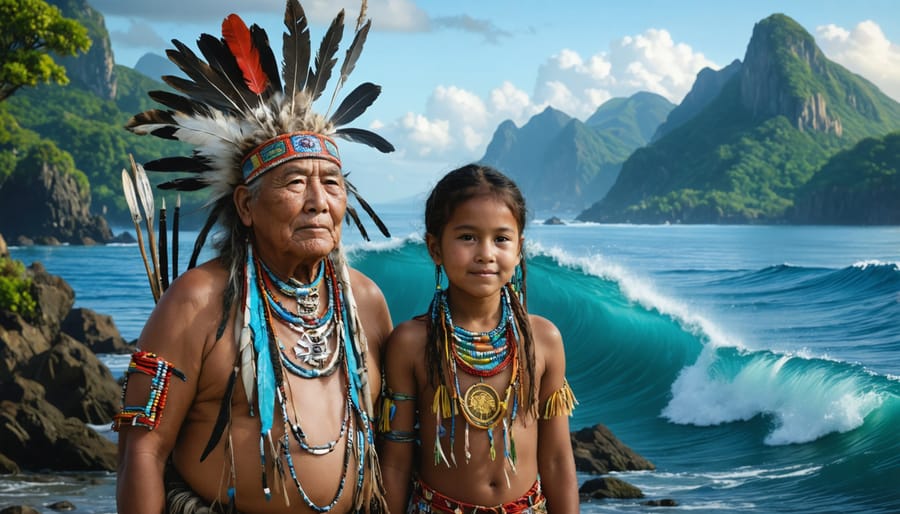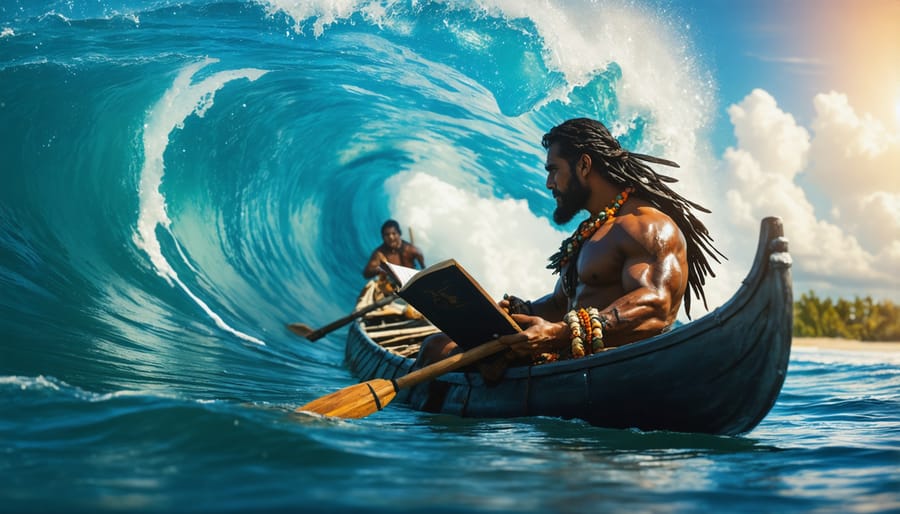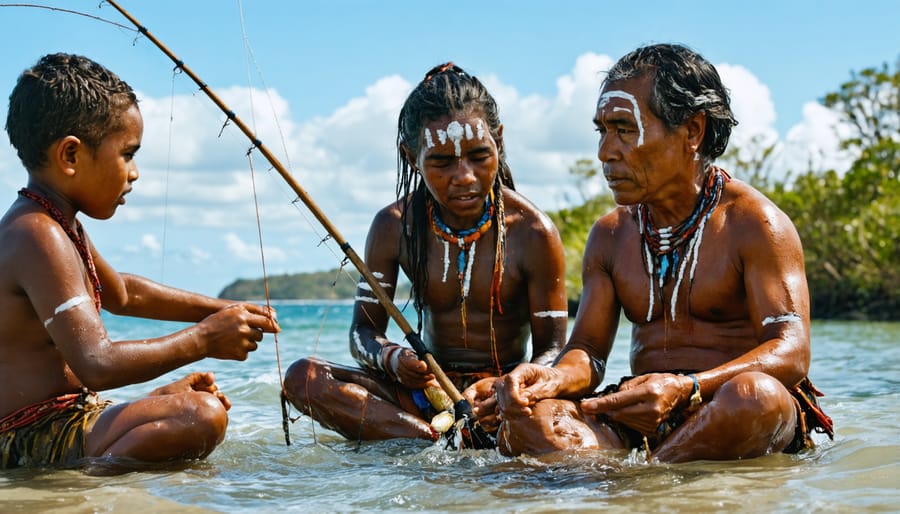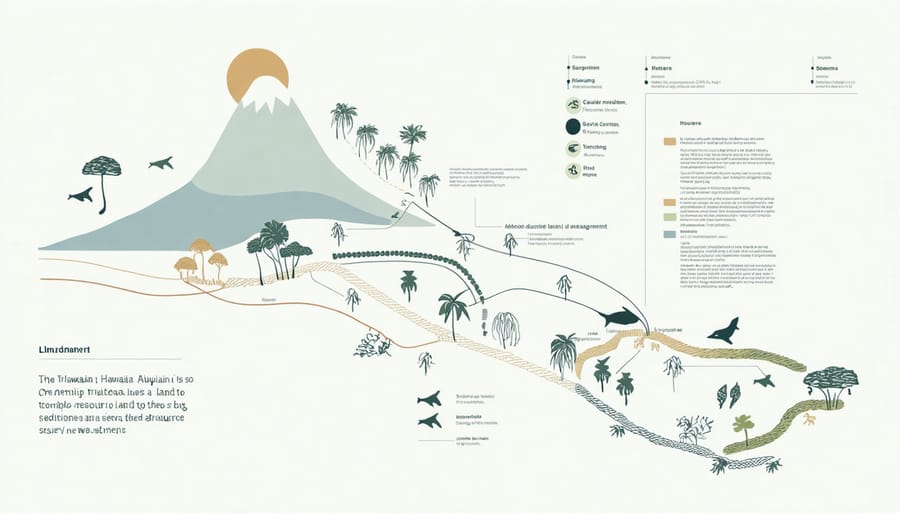
For millennia, indigenous ocean knowledge has shaped our understanding of sustainable resource management, offering profound insights that modern science is only beginning to fully appreciate. From the intricate reef management systems of Pacific Islander communities to the sophisticated salmon stewardship practices of Northwest Coast tribes, indigenous peoples have developed sophisticated environmental knowledge systems through generations of careful observation and practical application. These time-tested practices not only demonstrate remarkable ecological understanding but also offer vital solutions for today’s environmental challenges. As climate change and biodiversity loss threaten global ecosystems, indigenous knowledge systems provide proven frameworks for sustainable resource management, species conservation, and ecosystem restoration. This article explores five compelling examples where traditional ecological knowledge has contributed significantly to environmental conservation, highlighting how ancient wisdom continues to inform and enhance modern scientific approaches to protecting our natural world.
Traditional Navigation in Pacific Island Communities

Wave Pattern Reading
Indigenous Pacific Island navigators have long relied on wave patterns to traverse vast oceanic distances, a practice that continues to influence modern navigation and marine conservation programs. By observing how waves interact with islands, reefs, and underwater formations, traditional navigators can determine their position and identify optimal sailing routes without modern instruments.
This knowledge has proven invaluable in establishing marine protected area boundaries, particularly in the Pacific region. Indigenous communities identify crucial marine habitats and migration corridors by reading wave patterns that indicate underwater topography and marine life movements. For example, in Hawaii, traditional wave pattern reading helped determine the boundaries of the Papahānaumokuākea Marine National Monument, ensuring protection of vital ecosystems.
Scientists now collaborate with indigenous experts to combine traditional wave pattern knowledge with modern oceanographic data, creating more effective conservation strategies that respect both scientific and cultural understanding of marine environments. This integration has enhanced our ability to predict storm patterns, identify fish spawning grounds, and establish more effective marine sanctuary boundaries.
Aboriginal Sea Country Management in Australia

Seasonal Fishing Practices
Indigenous communities worldwide have developed sophisticated timing systems for sustainable fishing, based on generations of observation and experience. In the Pacific Islands, traditional fishers follow lunar calendars to determine optimal fishing periods, recognizing patterns in fish spawning and migration that coincide with specific moon phases. These ancient practices often align perfectly with modern scientific data on marine species’ reproductive cycles.
The Aboriginal peoples of Australia’s coastal regions traditionally practice seasonal fishing restrictions, allowing certain species to recover during specific months. This knowledge has influenced contemporary fishing regulations in marine protected areas. Similarly, Native Alaskan communities have long-established guidelines for salmon harvesting, timing their catches to ensure sufficient numbers reach spawning grounds.
Many modern fishery management policies now incorporate these time-tested indigenous practices, recognizing their effectiveness in maintaining healthy fish populations. This integration of traditional knowledge with scientific management has proven particularly successful in areas where indigenous communities actively participate in conservation planning and policy-making.
Inuit Knowledge of Arctic Marine Ecosystems
The Inuit people of the Arctic have developed sophisticated knowledge of marine ecosystems through generations of observation and experience. Their understanding of sea ice patterns, marine mammal migration routes, and ecological relationships has proven invaluable for modern conservation efforts and our comprehension of climate change impacts on marine ecosystems.
Traditional Inuit hunters can read subtle changes in ice formation, identifying dangerous areas and optimal hunting locations through careful observation of color, texture, and sound. This knowledge has helped scientists better understand Arctic sea ice dynamics and predict seasonal changes that affect marine life.
The Inuit’s detailed understanding of beluga whale and narwhal behavior has contributed significantly to marine protected area planning. Their observations of feeding grounds, calving areas, and migration patterns have helped establish conservation zones that better protect these species while respecting traditional hunting practices.
Through collaborative research programs, Inuit communities work alongside marine biologists to monitor seal populations and document changing Arctic conditions. Their ability to track and interpret animal behavior patterns has revealed previously unknown feeding relationships and habitat preferences, leading to more effective conservation strategies.
This knowledge integration has become increasingly crucial as Arctic ecosystems face rapid environmental changes. Conservation policies now regularly incorporate Inuit perspectives, creating more comprehensive and culturally sensitive approaches to marine resource management that benefit both wildlife and local communities.
Traditional Chilean Coastal Management
Along Chile’s extensive coastline, indigenous fishing communities have maintained a sophisticated system of marine resource management that dates back centuries. The Lafkenche people, in particular, have developed intricate knowledge of ocean currents, fish migration patterns, and sustainable harvesting practices that continue to influence modern conservation efforts.
These communities establish and maintain areas known as “Espacios Costeros Marinos de Pueblos Originarios” (ECMPO), or Marine Coastal Spaces of Indigenous Peoples. Within these zones, traditional fishing methods such as stone-wall fish traps and selective harvesting techniques help maintain healthy fish populations while ensuring food security for local communities.
One notable practice is the rotation of harvesting grounds, where specific areas are left untouched for predetermined periods, allowing marine resources to regenerate naturally. This system mirrors modern marine protected areas but incorporates cultural and spiritual elements that strengthen community commitment to conservation.
The Lafkenche people’s traditional calendar, which identifies optimal harvesting times based on lunar cycles and seasonal changes, has proven remarkably accurate in predicting fish abundance and spawning periods. Modern marine biologists have begun incorporating this knowledge into scientific studies, finding that indigenous observations often align with contemporary research findings.
Recent legislation in Chile has started recognizing these traditional management systems, creating a framework where indigenous knowledge and modern conservation strategies work in harmony to protect marine biodiversity.

Hawaiian Traditional Marine Management
The Hawaiian ahupua’a system represents one of history’s most sophisticated approaches to ecosystem-based management. This traditional resource management system divided islands into wedge-shaped sections extending from mountain ridges to outer reefs, recognizing the intricate connection between terrestrial and marine ecosystems.
Within each ahupua’a, Native Hawaiians implemented careful restrictions on fishing practices, including kapu (taboo) periods that aligned with species spawning cycles. These regulations ensured sustainable harvest levels and protected marine biodiversity. The system also incorporated sophisticated fish pond aquaculture, known as loko i’a, which provided reliable food sources while maintaining natural fish populations.
Today, environmental scientists and marine managers are increasingly turning to ahupua’a principles to inform modern conservation strategies. The Hawaii Institute of Marine Biology has integrated traditional knowledge into its reef management programs, while community-based initiatives like the Hui Malama o Mo’omomi on Molokai demonstrate successful revival of traditional practices.
The ahupua’a concept’s emphasis on interconnected ecosystems mirrors contemporary watershed management approaches. Local communities are now establishing modern versions of traditional fishing calendars and marine protected areas based on ancient Hawaiian boundaries. This integration of indigenous wisdom with current scientific methods has shown promising results in coral reef restoration and fish population recovery, offering a model for other coastal regions worldwide.
The integration of indigenous knowledge into marine policy represents a crucial step forward in sustainable ocean management. As demonstrated through these examples, traditional ecological knowledge offers unique insights that complement modern scientific approaches, creating more comprehensive and effective conservation strategies. The success stories from various indigenous communities worldwide highlight the importance of collaborative approaches that respect and incorporate centuries-old wisdom with contemporary conservation methods.
Looking ahead, the growing recognition of indigenous knowledge systems opens new possibilities for marine conservation. By bridging traditional and scientific knowledge, we can develop more resilient and culturally appropriate solutions to pressing environmental challenges. This integration also promotes social justice by acknowledging and respecting indigenous rights and contributions to environmental stewardship.
The future of marine conservation lies in creating inclusive frameworks that value diverse knowledge systems. As we face increasing threats to ocean ecosystems, the combination of indigenous wisdom and modern science offers our best hope for developing sustainable solutions. Moving forward, it’s essential to continue building partnerships with indigenous communities, supporting their role as environmental stewards, and ensuring their voices are heard in policy-making processes.
jessica
Ava Singh is an environmental writer and marine sustainability advocate with a deep commitment to protecting the world's oceans and coastal communities. With a background in environmental policy and a passion for storytelling, Ava brings complex topics to life through clear, engaging content that educates and empowers readers. At the Marine Biodiversity & Sustainability Learning Center, Ava focuses on sharing impactful stories about community engagement, policy innovations, and conservation strategies. Her writing bridges the gap between science and the public, encouraging people to take part in preserving marine biodiversity. When she’s not writing, Ava collaborates with local initiatives to promote eco-conscious living and sustainable development, ensuring her work makes a difference both on the page and in the real world.
